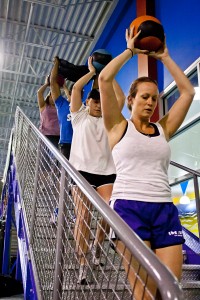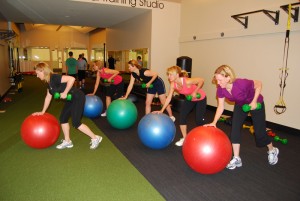
In the center of The Rush Fitness Complex, a small group of members exercise with ropes, jump on obstacles and throw around large, weighted balls. Members at The Rush are participating in an intense small-group-training program called The Rush 212 Degree XTREME workout. And, although they may be having as much fun as if they were playing on a playground, they’re also getting a highly effective workout.
“At 211 degrees, water is just hot water,” said Tony Gray, the vice president of fitness at The Rush Fitness Complex and the creator of the Rush 212 Degree XTREME program. “At 212 degrees, it’s boiling water. We want members to put in that extra degree of effort,” he said. At The Rush, small group training proved to be the best way to do that for its members.
Targeting a Specific Group
The Rush started its small-group-training program in April 2012 to target a group of members it wasn’t reaching through Group X and personal training. “With one-on-one it’s more about your connection with the client,” said Gray. “Small group training is more about the actual workout. The people in the group end up bonding.”
In the first month of the program 700 people across The Rush’s 23 locations signed up to participate in the 212 XTREME program. In groups of 10 to 14 people, members work out in a fast-paced, high-energy atmosphere that appeals to members who want extra motivation. “It’s definitely high energy,” said Gray. “When one of those sessions is going on you can really feel a difference in the club. People like some level of competition — the whole group thing really does create that.”
The high energy and competition is part of what appeals to a certain member demographic — the member who isn’t excited by personal training and large Group X classes. During one of the 212 XTREME classes, members tackle the “Ring of Fire,” a large fitness octagon invented by Gray. With eight stations boasting elements such as monkey bars and suspension training, the Ring of Fire gives members a total-body workout, while trainers scream, “Push through it! Push through it!”
Profitability
Mountainside Fitness began implementing small group training in 2010 after noticing a shift in industry trends. “We saw two shifts in the market that compelled us to adjust our operations to capitalize on this rising trend,” said Billy Malkovich, the CEO of Mountainside Fitness. “The first thing we saw was a steep climb in group fitness attendance. Second, we saw one-on-one training numbers only marginally increasing. We needed to find a new product that would provide motivation as well as the social aspect, which so many of our customers now desire.”
Small group training proved to be the perfect solution. “It opened up a new market and revenue stream,” explained Malkovich. “People who would never step foot in a group fitness room are now leaving the bench press and joining a TRX class along with seven other people.”
Using programs they already had at their disposal, such as TRX, boxing, Pilates and yoga — Malkovich saved on programming by taking those formats and molding them to work in small groups. “The best thing about small group training is that its content is already created either in a large group fitness class or a one-on-one personal training session,” said Malkovich. “All you need to do is adjust the size and scope to match the needs of six people, versus one or 40.”
By grouping training into small groups, members are rewarded with an appealing, effective program that runs at a lower cost than personal training. “If you think about it, it’s really affordable,” said Gray. The Rush charges members $79 per month for a small group program, versus personal training, which can cost the member around $50 per session.
Although it’s cheaper for the member — for The Rush and Mountainside, it has proven to be the most profitable program for the club. “In doing activity-based cost/revenue analysis on this space, we have found that it is among the highest revenue generating, lowest-cost space in our building,” said Malkovich. “Cost and revenue aside, it’s among the most used space per square foot in our facilities.”
“[Small group training] is by far the single, most profitable thing you can do,” said Gray. “The customer can actually pay less, the gym gains profit and you can pay your employees more.”
The Instructor
Due to the high-energy of the classes, small group training requires a specific type of instructor. “Coaching in a small group is not personal training,” stressed Vic Spatola, the director of personal training at Greenwood Athletic and Tennis Club. “When your client is in a one-on-one session and makes a gross error, you can stop and analyze and problem solve why they are doing that. In a small group, the participant must have a certain level of competency with exercise before training in a group. Coaching in a small group has to have a general focus on the quality of the movement and the focus of the training so each individual gets what they are hoping to get from the training.”
Before signing up members into small group training, instructors first have to determine whether or not the client is suited for that type of atmosphere, and what they’re hoping to get out of it. “The trainer needs to assess each client and determine their needs and goals and which form of group training would get them to their goals the fastest, depending on their schedule and financial commitment,” said Spatola.
To make sure members are getting the most out of their workouts, Greenwood offers members specifically tailored small-group classes, ranging from TRX focused on cardio, Olympic lift weight training and Kettlebell classes. “Each group training session has a very specific focus of training. Because we are training up to 12 in a class, we cannot tailor the workout like you can in a one-on-one session. So the focus of training has to be very specific to attract clients that want that type of workout,” explained Spatola.
At The Rush Fitness Complex, “The trainers are the motivators, the drill sergeants, the drivers,” said Gray. “They don’t give a lot of form critiquing — the trainer becomes the motivator.”
Although small group training differs from Group X, the camaraderie and group-mentality also leads to members’ accountability. “The members bond with each other,” said Gray. “It’s amazing at how fast it happens. Within two classes, people become best friends.”
In 45 minutes to an hour, small group training can lead to big results — in both gym revenue, and member outreach and satisfaction. “The way we look at it, anything can become small group training (i.e. Pilates, physical therapy, yoga). Whatever it is you do, you can form into a small group,” said Gray.
To get the most out of your small group programs, market heavily through ads, e-mail and word of mouth. However, at the end of the day, the biggest advertisement may be a small group class held at the center of your club. To most members, the energy visibly spilling from the class will be irresistible.
By Rachel Zabonick
Stay ahead in the fitness industry with exclusive updates!
Rachel Zabonick-Chonko is the editor-in-chief of Club Solutions Magazine. She can be reached at rachel@peakemedia.com.












